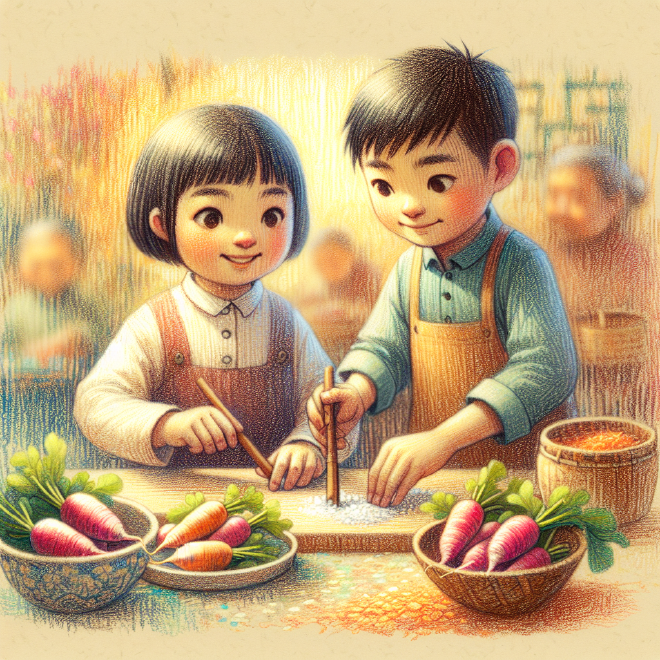盲盒奇遇

Table of Contents
Audio #
汉字 #
冬天快到了,小明和丽丽决定学习奶奶的腌萝卜制作方法。奶奶说:“腌萝卜的第一步是挑选好的萝卜。”他们去了市场,奶奶教他们挑选又大又白的萝卜,小明负责拿篮子,丽丽负责仔细检查萝卜。
回到家里,奶奶把萝卜切成薄片。小明和丽丽也跟着学习,虽然一开始切得不太整齐,但奶奶鼓励他们:“多练习,你们一定能切得很好!”切完后,奶奶开始准备腌制的佐料,比如盐、糖和醋。她教小明和丽丽每种材料的比例。
腌制的时候,小明负责加入佐料,丽丽负责搅拌。他们一边工作一边说笑,整个厨房都充满了欢声笑语。奶奶看着他们说:“真是我的好帮手!”几个小时后,腌萝卜终于做好了,他们尝了一下,都觉得味道非常好。
丽丽开心地说:“下次我们还可以试着腌其他的蔬菜!”小明点点头:“对啊,我觉得腌萝卜比我想象的容易很多!”
Pinyin #
Dōngtiān kuài dàole, Xiǎomíng hé Lìlì juédìng xuéxí nǎinai de yān luóbo zhìzuò fāngfǎ. Nǎinai shuō: “Yān luóbo de dì yī bù shì tiāoxuǎn hǎo de luóbo.” Tāmen qùle shìchǎng, nǎinai jiào tāmen tiāoxuǎn yòu dà yòu bái de luóbo, Xiǎomíng fùzé ná lánzi, Lìlì fùzé zǐxì jiǎnchá luóbo.
Huí dào jiā lǐ, nǎinai bǎ luóbo qiē chéng bó piàn. Xiǎomíng hé Lìlì yě gēnzhe xuéxí, suīrán yī kāishǐ qiē de bú tài zhěngqí, dàn nǎinai gǔlì tāmen: “Duō liànxí, nǐmen yídìng néng qiē de hěn hǎo!” Qiē wán hòu, nǎinai kāishǐ zhǔnbèi yānzhì de zuóliào, bǐrú yán, táng hé cù. Tā jiào Xiǎomíng hé Lìlì měi zhǒng cáiliào de bǐlì.
Yānzhì de shíhòu, Xiǎomíng fùzé jiārù zuóliào, Lìlì fùzé jiǎobàn. Tāmen yìbiān gōngzuò yìbiān shuōxiào, zhěngge chúfáng dōu chōngmǎnle huānshēng xiàoyǔ. Nǎinai kànzhe tāmen shuō: “Zhēnshi wǒ de hǎo bāngshǒu!” Jǐge xiǎoshí hòu, yān luóbo zhōngyú zuò hǎole, tāmen chángle yíxià, dōu juéde wèidào fēicháng hǎo.
Lìlì kāixīn de shuō: “Xiàcì wǒmen hái kěyǐ shìzhe yān qítā de shūcài!” Xiǎomíng diǎn diǎn tóu: “Duì a, wǒ juéde yān luóbo bǐ wǒ xiǎngxiàng de róngyì hěn duō!”
English Translation #
Winter is approaching, and Xiaoming and Lili decided to learn how to make pickled radishes from their grandmother. Grandma said, “The first step of making pickled radishes is choosing good radishes.” They went to the market, and Grandma taught them how to select big and white radishes. Xiaoming carried the basket, while Lili carefully inspected the radishes.
At home, Grandma sliced the radishes into thin pieces. Xiaoming and Lili followed her lead, although their slices were not very neat at first. Grandma encouraged them, saying, “Practice more, and you’ll definitely get better!” After slicing, Grandma prepared the pickling ingredients, such as salt, sugar, and vinegar, and taught them the proportions.
During the pickling process, Xiaoming added the ingredients while Lili stirred the mixture. They chatted and laughed as they worked, filling the kitchen with joy. Grandma smiled and said, “You’re such good helpers!” After a few hours, the pickled radishes were finally ready. They tasted them and agreed that they were delicious.
Lili happily said, “Next time, we can try pickling other vegetables!” Xiaoming nodded and replied, “Yes, I think making pickled radishes is much easier than I imagined!”
Grammatical Points and Analysis #
Resultative Complements: #
- 切得很好 (qiē de hěn hǎo): “cutting well.” The complement structure indicates the result of the action.
Verb-Object Phrases: #
- 加入佐料 (jiārù zuóliào): “adding seasoning.” A verb-object construction that reflects a specific action.
Adjective-Adjective Structure: #
- 又大又白 (yòu dà yòu bái): “big and white.” This structure pairs two adjectives with the word 又 (yòu) to describe qualities of the radishes.
Percentages/Proportions: #
- 奶奶教小明和丽丽每种材料的比例 (Nǎinai jiào Xiǎomíng hé Lìlì měi zhǒng cáiliào de bǐlì): “Grandma taught Xiaoming and Lili the proportions for each ingredient.”
Coordination in Dialogue: #
- 用说笑表达欢快气氛 (Yòng shuōxiào biǎodá huānkuài qìfēn): Describing emotions through dialogue in a narrative.
Questions #
1. Grandma says the first step is choosing good radishes. Who inspected the radishes carefully? #
奶奶说第一步是挑选好的萝卜。谁仔细检查了萝卜? Nǎinai shuō dì yī bù shì tiāoxuǎn hǎo de luóbo. Shéi zǐxì jiǎnchá le luóbo?
Click to show the answer
answer #
丽丽检查了萝卜。 Lìlì jiǎnchá le luóbo. Lili inspected the radishes.
2. What ingredients were used for pickling the radishes? #
腌萝卜的时候用到了哪些佐料? Yān luóbo de shíhou yòng dàole nǎxiē zuóliào?
Click to show the answer
answer #
腌萝卜的时候用到了盐、糖和醋。 Yān luóbo de shíhou yòng dàole yán, táng hé cù. Salt, sugar, and vinegar were used for pickling the radishes.
Disclaimer: This story is purely fictional and generated by AI. Any similarities to real people, places, or events are purely coincidental.